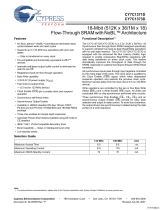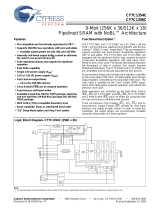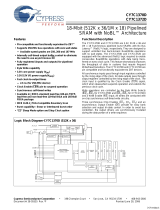
CY7C1471V33
CY7C1473V33
CY7C1475V33
Document #: 38-05288 Rev. *J Page 14 of 32
TAP Registers
Registers are connected between the TDI and TDO balls and
enable data to be scanned into and out of the SRAM test
circuitry. Only one register can be selected at a time through
the instruction register. Data is serially loaded into the TDI ball
on the rising edge of TCK. Data is output on the TDO ball on
the falling edge of TCK.
nstruction Register
Three-bit instructions can be serially loaded into the instruction
register. This register is loaded when it is placed between the
TDI and TDO balls as shown in the “TAP Controller Block
Diagram” on page 13. During power up, the instruction register
is loaded with the IDCODE instruction. It is also loaded with
the IDCODE instruction if the controller is placed in a reset
state as described in the previous section.
When the TAP controller is in the Capture-IR state, the two
least significant bits are loaded with a binary ‘01’ pattern to
enable fault isolation of the board-level serial test data path.
Bypass Register
To save time when serially shifting data through registers, it is
sometimes advantageous to skip certain chips. The bypass
register is a single-bit register that can be placed between the
TDI and TDO balls. This allows data to be shifted through the
SRAM with minimal delay. The bypass register is set LOW
(V
SS
) when the BYPASS instruction is executed.
Boundary Scan Register
The boundary scan register is connected to all the input and
bidirectional balls on the SRAM.
The boundary scan register is loaded with the contents of the
RAM IO ring when the TAP controller is in the Capture-DR
state and is then placed between the TDI and TDO balls when
the controller is moved to the Shift-DR state. The EXTEST,
SAMPLE/PRELOAD and SAMPLE Z instructions can be used
to capture the contents of the IO ring.
The Boundary Scan Order tables show the order in which the
bits are connected. Each bit corresponds to one of the bumps
on the SRAM package. The MSB of the register is connected
to TDI and the LSB is connected to TDO.
Identification (ID) Register
The ID register is loaded with a vendor-specific, 32-bit code
during the Capture-DR state when the IDCODE command is
loaded in the instruction register. The IDCODE is hardwired
into the SRAM and can be shifted out when the TAP controller
is in the Shift-DR state. The ID register has a vendor code and
other information described in “Identification Register Defini-
tions” on page 18.
TAP Instruction Set
Overview
Eight different instructions are possible with the three-bit
instruction register. All combinations are listed in “Identification
Codes” on page 18. Three of these instructions are listed as
RESERVED and must not be used. The other five instructions
are described in detail below.
The TAP controller used in this SRAM is not fully compliant to
the 1149.1 convention because some of the mandatory 1149.1
instructions are not fully implemented.
The TAP controller cannot be used to load address data or
control signals into the SRAM and cannot preload the IO
buffers. The SRAM does not implement the 1149.1 commands
EXTEST or INTEST or the PRELOAD portion of
SAMPLE/PRELOAD; rather, it performs a capture of the IO
ring when these instructions are executed.
Instructions are loaded into the TAP controller during the
Shift-IR state when the instruction register is placed between
TDI and TDO. During this state, instructions are shifted
through the instruction register through the TDI and TDO balls.
To execute the instruction after it is shifted in, the TAP
controller needs to be moved into the Update-IR state.
EXTEST
EXTEST is a mandatory 1149.1 instruction which is to be
executed whenever the instruction register is loaded with all
0s. EXTEST is not implemented in this SRAM TAP controller,
and therefore this device is not compliant to 1149.1. The TAP
controller does recognize an all-0 instruction.
When an EXTEST instruction is loaded into the instruction
register, the SRAM responds as if a SAMPLE/PRELOAD
instruction has been loaded. There is one difference between
the two instructions. Unlike the SAMPLE/PRELOAD
instruction, EXTEST places the SRAM outputs in a High-Z
state.
IDCODE
The IDCODE instruction causes a vendor-specific, 32-bit code
to be loaded into the instruction register. It also places the
instruction register between the TDI and TDO balls and
enables the IDCODE to be shifted out of the device when the
TAP controller enters the Shift-DR state.
The IDCODE instruction is loaded into the instruction register
during power up or whenever the TAP controller is in a test
logic reset state.
SAMPLE Z
The SAMPLE Z instruction causes the boundary scan register
to be connected between the TDI and TDO balls when the TAP
controller is in a Shift-DR state. It also places all SRAM outputs
into a High-Z state.
SAMPLE/PRELOAD
SAMPLE/PRELOAD is a 1149.1 mandatory instruction. The
PRELOAD portion of this instruction is not implemented, so
the device TAP controller is not fully 1149.1 compliant.
When the SAMPLE/PRELOAD instruction is loaded into the
instruction register and the TAP controller is in the Capture-DR
state, a snapshot of data on the inputs and bidirectional balls
is captured in the boundary scan register.
The user must be aware that the TAP controller clock can only
operate at a frequency up to 20 MHz, while the SRAM clock
operates more than an order of magnitude faster. Because
there is a large difference in the clock frequencies, it is
possible that during the Capture-DR state, an input or output
may undergo a transition. The TAP may then try to capture a
[+] Feedback


























